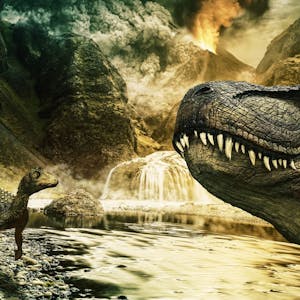This course, offered by Emory University, delves into the history of mass extinctions, their causes, and impact on life on Earth. It introduces the five mass extinctions of the pre-human past, their significance to the history of life on Earth, and the current mass extinction happening during our time. The course also explores the history of paleontology and geological study, and reviews the key players that influenced the science today.
Throughout the course, students will learn to summarize extinctions as an important part of the history of life, identify the probable causes of mass extinctions in the geologic past, compare and contrast the Big Five mass extinctions with human-influenced extinctions, and evaluate historical lessons and current trends to predict and prevent extinctions of the future.
The course comprises modules that cover topics such as the introduction to extinctions, human awareness of extinctions throughout history, the mass extinctions of the pre-human past, extinctions of pre-history & near-present, and extinctions since European colonization and going into the future. Each module includes engaging content, handouts, quizzes, and practical exercises designed to enhance the learning experience.
Certificate Available ✔
Get Started / More Info
This course comprises modules covering the introduction to extinctions, human awareness of extinctions throughout history, mass extinctions of the pre-human past, extinctions of pre-history & near-present, and extinctions since European colonization and going into the future.
Welcome to the course! This module introduces the concept of extinctions, distinguishing between "mass" and "normal" extinctions, and explores the role of extinctions in evolution. It also provides an outline of the course and grading information.
This module delves into the history of human awareness of extinctions, including legends from ancient and indigenous cultures, Renaissance and post-Enlightenment theories on previous life, and the birth of modern geology and paleontology. It also covers key figures such as Mary Anning and Victorian dinosaurs.
This module explores the five mass extinctions of the pre-human past, including the End-Ordovician, End-Devonian, End-Permian, End-Triassic, and End-Cretaceous extinctions. It also examines the commonalities and differences between these extinctions and covers topics such as precambrian life, rise of oxygen, and deadly plants.
Here, the course covers extinctions of pre-history and near-present, including European, North & South American, Australian, and New Zealand & Madagascar extinctions. It also discusses the "Overkill" hypothesis and alternative explanations for extinctions, as well as the ecological after-effects of megafauna extinction.
This module focuses on extinctions since European colonization and going into the future. It covers the Anthropocene Epoch, colonization and habitat alteration, the rise of conservation biology, rewilding hypothesis, "de-extinction," modern climate change, and the new geologic epoch and habitat alteration.
Sustainable Cities empowers individuals and organizations with strategies for creating and supporting sustainable urban environments, emphasizing smart growth and...
Mobilités et véhicules électriques - Explorez l'avenir de la mobilité durable et des véhicules électriques à travers une approche multidisciplinaire intégrant...
This course equips learners with the knowledge and skills to navigate national code and zoning rules specific to photovoltaic systems, along with key design elements...
Agroforestry I: Principles and Practices offers a comprehensive study of sustainable land-use through the integrated approach of growing trees and crops. Students...